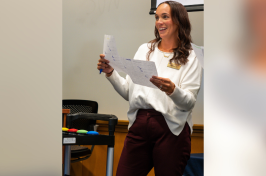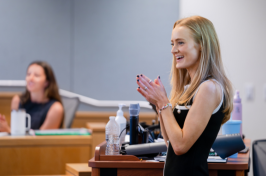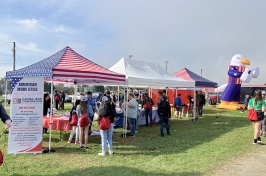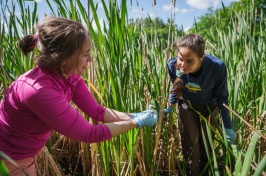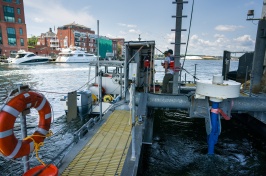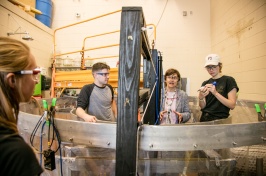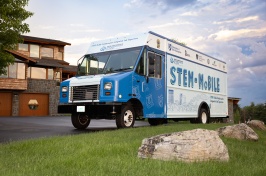UNH Agricultural Research Boosts New Englands Thanksgiving Bounty

Different varieties of Brussels sprouts are being grown at the UNH Woodman Horticultural Research Farm to investigate which ones have the highest marketable yields for the region. Credit: UNH
DURHAM, N.H. - As New Englanders sit down to give thanks this week, their Thanksgiving table may be filled with an abundant supply of locally grown foods thanks, in part, to extensive agricultural research conducted by the NH Agricultural Experiment Station at the University of New Hampshire.
What would Thanksgiving be without winter squash and pumpkins? Due to five decades of research by J. Brent Loy, emeritus professor of plant genetics and a researcher with the NH Agricultural Experiment Station, New Englanders now enjoy some of the tastiest squash and pumpkins on the market today. Loy's research, which has largely taken place at the experiment station's Kingman Farm, has resulted in more than 60 new varieties of squash, pumpkins, gourds, and melons sold in seed catalogs throughout the world and represents the longest continuous squash and pumpkin breeding program in North America.
Brussels sprouts are a staple at most Thanksgiving feasts. Experiment station researcher Becky Sideman, who also is an extension professor of sustainable horticulture production, recently conducted the first study on growing Brussels sprouts in northern New England. She found that different varieties of the vegetable perform much better than others, and the practice of topping has the potential to increase marketable yields. The research was conducted at the UNH Woodman Horticultural Research Farm, an experiment station facility.
Sideman's Thanksgiving meal contributions also extend to sweet potatoes. In the first study of the performance of modern sweet potato cultivars in northern regions, she found that sweet potatoes can be a viable crop for growers in climates with short growing seasons such as New England. New Englanders might consider sweet potatoes more of a southern Thanksgiving side dish or dessert, but since 2007, sweet potato acreage throughout the New England states has increased more than eight-fold from four to 33 acres, all for fresh-market sales with most individual producers having small plantings of less than half an acre, according to the U.S. Department of Agriculture.
And Sideman is making sure that New Englanders have a local source of onions for their Thanksgiving meals, even when the snow flies. In response to high demand for year-round local produce, Sideman has successfully grown bulbing onions planted in fall for a spring harvest with the aid of inexpensive low tunnels.
For those in the Northeast who enjoy a southern favorite -- oyster dressing -- experiment station researchers are helping make the oysters they eat more safe. Cheryl Whistler, associate professor of molecular, cellular, and biomedical sciences and an experiment station researcher, discovered a new method to detect a bacterium that has contaminated New England oyster beds and sickened consumers who ate the contaminated shellfish. The new patent-pending detection method is a significant advance in efforts to identify shellfish harboring disease-carrying strains of Vibrio parahaemolyticus.
Many lovers of apple pie enjoy a hefty scoop of vanilla ice cream on the side. For consumers of Hood vanilla ice cream (and those getting a head start on their egg nog,) they will be enjoying products made from some of the finest milk in the region. Hood sources some of its milk from the Fairchild Dairy Teaching and Research Center, which has been long recognized for its quality milk and operations. In 2014, 2013 and 2012, the farm received the Gold Quality Award from the Dairy Farmers of America. Also in 2014, the New Hampshire Department of Health and Human Services recognized the dairy as a New Hampshire Quality Milk Producer. In 2013, the farm received a Quality Milk Award from Dairy One for consistently producing high quality milk with a low somatic cell count. In 1997 and 2004, Dairy One also recognized the CREAM herd as having the highest quality milk from among approximately 3,100 dairy herds on the official Northeast Dairy Herd Improvement Association (DHIA) test.
And someday, kiwiberry wine might become a staple for New Englanders with their turkey because of UNH's efforts to promote kiwiberries as a new, high-value crop in northern New Hampshire. Plant breeder and experiment station researcher Iago Hale established a kiwiberry breeding program in 2012 at UNH's Woodman Horticultural Research Farm. Initial work is focused on characterizing and evaluating the North American collection of cold-hardy kiwis, nearly 200 accessions, to identify promising varieties for the region and parent plants for new variety development.
Happy Thanksgiving from the NH Agricultural Experiment Station.
Founded in 1887, the NH Agricultural Experiment Station at the UNH College of Life Sciences and Agriculture is UNH's original research center and an elemental component of New Hampshire's land-grant university heritage and mission. We steward federal and state funding, including support from the USDA National Institute of Food and Agriculture, to provide unbiased and objective research concerning diverse aspects of sustainable agriculture and foods, aquaculture, forest management, and related wildlife, natural resources and rural community topics. We maintain the Woodman and Kingman agronomy and horticultural farms, the Macfarlane Greenhouses, the Fairchild Dairy Teaching and Research Center, and the Organic Dairy Research Farm. Additional properties also provide forage, forests and woodlands in direct support to research, teaching, and outreach.
The University of New Hampshire, founded in 1866, is a world-class public research university with the feel of a New England liberal arts college. A land, sea, and space-grant university, UNH is the state's flagship public institution, enrolling 13,000 undergraduate and 2,500 graduate students.
PHOTOS AVAILABLE FOR DOWNLOAD
https://colsa.unh.edu/sites/colsa.unh.edu/files/brentloyunh.jpg
J. Brent Loy, emeritus professor of plant genetics and a researcher with the NH Agricultural Experiment Station, is a global leader in breeding pumpkins and squash. Credit: UNH
https://colsa.unh.edu/sites/colsa.unh.edu/files/brusselssprouts.jpg
Different varieties of Brussels sprouts are being grown at the UNH Woodman Horticultural Research Farm to investigate which ones have the highest marketable yields for the region. Credit: UNH
https://colsa.unh.edu/sites/colsa.unh.edu/files/sweetpotatoplants.JPG
UNH evaluated the performance of several sweet potato cultivars grown on raised beds covered with biodegradable black mulch at the UNH Woodman Horticultural Research Farm. Credit: UNH
https://colsa.unh.edu/sites/colsa.unh.edu/files/onionsinwinter.jpg
Inside these icy low tunnels are hundreds of onion plants, tucked in for the winter. Credit: UNH
https://colsa.unh.edu/sites/colsa.unh.edu/files/oysters2.jpg
Cheryl Whistler, associate professor of molecular, cellular, and biomedical sciences and a researcher with the NH Agricultural Experiment Station, discovered a new method to detect a bacterium that has contaminated New England oyster beds and sickened consumers who ate the contaminated shellfish. Credit: NH Sea Grant
https://colsa.unh.edu/sites/colsa.unh.edu/files/hardykiwis.jpg
Whether for fresh eating, winemaking, or other value-added products, Prof. Iago Hale is hopeful his research will lead to the establishment of a kiwiberry industry in New Hampshire. Credit: UNH
Latest News
-
October 30, 2024
-
October 10, 2024
-
October 8, 2024
-
October 3, 2024
-
October 1, 2024








